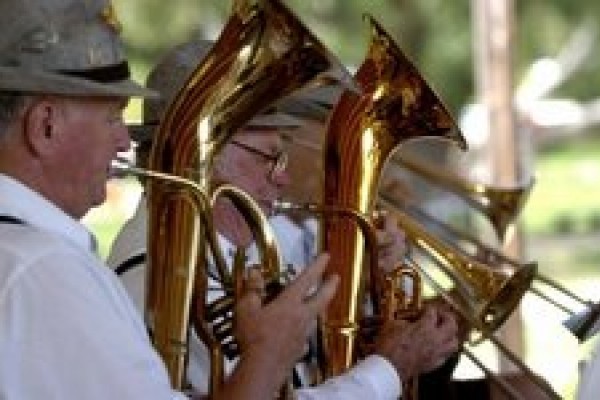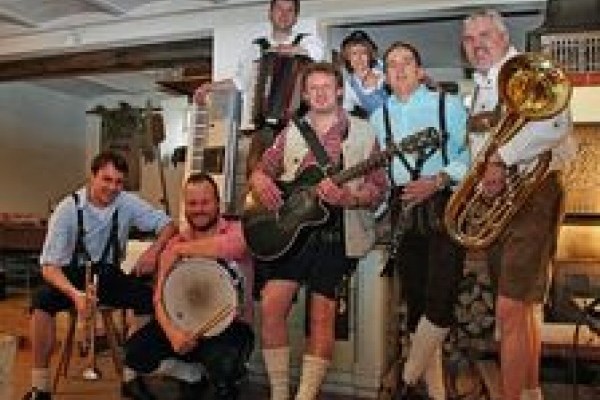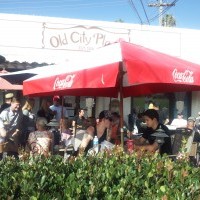ABOUT OKTOBERFEST
Oktoberfest is a 16-18 day festival held each year in Munich, Bavaria, Germany, running from late September to the first weekend in October. It is one of the most famous events in Germany and the world's largest fair, with more than 5 million people attending every year. The Oktoberfest is an important part of Bavarian culture. Other cities across the world also hold Oktoberfest celebrations, modelled after the Munich event.
The Munich Oktoberfest, traditionally, takes place during the sixteen days up to and including the first Sunday in October. In 1994, the schedule was modified in response to German reunification so that if the first Sunday in October falls on the 1st or 2nd, then the festival will go on until October 3 (German Unity Day). Thus, the festival is now 17 days when the first Sunday is October 2 and 18 days when it is October 1. In 2014, the festival lasts until the first Monday in October, to mark the 200-year anniversary of the event. The festival is held in an area named the Theresienwiese (field, or meadow, of Therese), often called Wiesn for short, located near Munich's centre.
Visitors eat huge amounts of traditional hearty fare such as Hendl (chicken), Schweinsbraten (roast pork), Schweinshaxe (ham hock), Steckerlfisch (grilled fish on a stick), Würstl (sausages) along with Brezn (Pretzel), Knödel (potato or bread dumplings), Kasspatzn (cheese noodles), Reiberdatschi (potato pancakes), Sauerkraut or Blaukraut (red cabbage) along with such Bavarian delicacies as Obatzda (a spiced cheese-butter spread) and Weisswurst (a white sausage).
History

The original "Oktoberfest" occurred in Munich, on October 12, 1810. For the public commemoration of their marriage that took place five days before, Crown Prince Ludwig (later King Ludwig I) and Princess Therese of Saxe-Hildburghausen (namesake of the Theresienwiese festival grounds) organized a great horse race. The event was so successful that it was decided to renew it in 1811.
First hundred years
In the year 1811, an agricultural show was added to boost Bavarian agriculture. The horse race persisted until 1960, the agricultural show still exists and it is held every four years on the southern part of the festival grounds. In 1816, carnival booths appeared; the main prizes were silver, porcelain, and jewelry. The founding citizens of Munich assumed responsibility for festival management in 1819, and it was agreed that the Oktoberfest would become an annual event. Later, it was lengthened and the date pushed forward, the reason being that days are longer and warmer at the end of September.
To honour the marriage of King Ludwig I and Therese of Bavaria, a parade took place for the first time in 1835. Since 1850, this has become a yearly event and an important component of the Oktoberfest. 8,000 people—mostly from Bavaria—in traditional costumes walk from Maximilian Street, through the centre of Munich, to the Oktoberfest. The march is led by the Münchner Kindl.

Since 1850, the statue of Bavaria has watched the Oktoberfest. This worldly Bavarian patron was first sketched by Leo von Klenze in a classic style and Ludwig Michael Schwanthaler romanticised and "Germanised" the draft; it was constructed by Johann Baptist Stiglmaier and Ferdinand von Miller.
In 1853, the Bavarian Ruhmeshalle was finished. In 1854, 3,000 residents of Munich succumbed to an epidemic of cholera, so the festival was cancelled. Also, in the year 1866, there was no Oktoberfest as Bavaria fought in the Austro-Prussian War. In 1870, the Franco-Prussian war was the reason for cancellation of the festival. In 1873, the festival was once more cancelled due to a cholera epidemic. In 1880, the electric light illuminated over 400 booths and tents (Albert Einstein helped install light bulbs in the Schottenhamel tent as an apprentice in his uncle's electricity business in 1896). In 1881, booths selling bratwursts opened. Beer was first served in glass mugs in 1892.
At the end of the 11th century, a re-organization took place. Until then, there were games of skittles, large dance floors, and trees for climbing in the beer booths. They wanted more room for guests and musicians. The booths became beer halls.
In 1887, the Entry of the Oktoberfest Staff and Breweries took place for the first time. This event showcases the splendidly decorated horse teams of the breweries and the bands that play in the festival tents. This event always takes place on the first Saturday of the Oktoberfest and symbolises the official prelude to the Oktoberfest celebration
In the year 1910, Oktoberfest celebrated its 100th birthday. 120,000 litres of beer were poured. In 1913, the Bräurosl was founded, which was the largest Oktoberfest beer tent of all time, with room for about 12,000 guests.
Facts and data
Size
The Oktoberfest is known as the Largest Volksfest (People's Fair) in the World. In 1999 there were six and a half million visitors to the 42 hectare Theresienwiese. 72% of the people are from Bavaria. 15% of visitors come from foreign countries like the surrounding EU-countries and other non-European countries including the United States, Canada, Australia and the Far East.
Besides the Oktoberfest, there are other public festivals that take place at the same location, in April/May: The Munich Frühlingsfest (Spring Festival) and Winter Tollwood in December with 650,000 visitors.
After the Oktoberfest the next people fairs in size in Germany are the Cranger Kirmes in Herne (Wanne-Eickel) (the largest fair in Northrhine-Westphalia) with 4.7 million visitors, the Rheinkirmes in Düsseldorf (called Largest Fair on the Rhine) and the Freimarkt in Bremen (the oldest fair in Germany, held since 1035, and the biggest fair in Northern Germany) with about 4 million visitors per year each, followed by the Cannstatter Volksfest in Stuttgart with about 3 million visitors each year and the "Schützenfest Hannover", the world's largest marksmen's Fun Fair in Hanover with about 2 million visitors per year.
Dates
| Year | Dates | Special Features |
|---|---|---|
| 2000 | Sep 16 – Oct 3 | |
| 2001 | Sep 22 – Oct 7 | |
| 2002 | Sep 21 – Oct 6 | |
| 2003 | Sep 20 – Oct 5 | |
| 2004 | Sep 18 – Oct 3 | with ZLF* |
| 2005 | Sep 17 – Oct 3 | 17 days |
| 2006 | Sep 16 – Oct 3 | 18 days |
| 2007 | Sep 22 – Oct 7 | |
| 2008 | Sep 20 – Oct 5 | 175th Oktoberfest (with ZLF*) |
| 2009 | Sep 19 – Oct 4 | |
| 2014 | Sep 18 – Oct 4 | 200th Anniversary (with BLF) |
| 2014 | Sep 17 – Oct 3 | 17 days |
| 2012 | Sep 22 – Oct 7 | |
| 2014 | Sep 21 – Oct 6 | |
| 2014 | Sep 20 – Oct 5 | |
| 2015 | Sep 19 – Oct 4 |
* Bayerisches Zentral-Landwirtschaftsfest (Bavarian Central Agriculture Festival)
Price of beer
During the last years the prices per Maß (1 liter stein) steadily increased (prices given in Euros)::
| Location | 2001 | 2002 | 2003 | 2008 | 2009 | 2014 |
|---|---|---|---|---|---|---|
| Ammer | 6,54 | 6,80 | 6,80 | 8,10 | 8,30 | 8,40 |
| Armbrustschützen | 6,49 | 6,75 | 6,75 | 8,20 | 8,55 | 8,75 |
| Augustiner Festhalle | 6,39 | 6,65 | 6,65 | 8,20 | 8,50 | 8,70 |
| Bräurosl-Festhalle | 6,39 | 6,70 | 6,70 | 8,25 | 8,55 | 8,80 |
| Bullinger Wurst | - | - | - | - | - | |
| Feisinger's Kas- und Weinstub'n | - | - | - | - | ||
| Fischer-Vroni | 6,49 | 6,80 | 6,80 | 8,25 | 8,60 | 8,90 |
| Glöckle Wirt | 6,29 | 6,70 | 6,70 | 8,10 | 8,40 | 8,70 |
| Hacker Festhalle | 6,54 | 6,80 | 6,80 | 8,30 | 8,60 | 8,80 |
| Heilmaier (Heinz) | 6,29 | 6,60 | 6,60 | 7,90 | 8,10 | 8,40 |
| Heimer Entenbraterei | 6,29 | 6,45 | 6,65 | 8,00 | 8,30 | 8,60 |
| Hippodrom | 6,54 | 6,70 | 6,70 | 8,30 | 8,60 | 8,80 |
| Hochreiter Haxnbraterei | 6,39 | 6,55 | 6,60 | 7,90 | 8,40 | 8,40 |
| Hochreiter, Zur Bratwurst | - | - | - | 8,10 | 8,60 | 8,60 |
| Hofbräu | 6,47 | 6,75 | 6,75 | 8,25 | 8,55 | 8,80 |
| Käfer Wiesn Schänke | 6,54 | 6,80 | 6,80 | 8,30 | 8,60 | 8,80 |
| Kalbskuchl | - | - | - | 7,90 | 8,30 | 8,40 |
| Knödelei | - | - | - | - | 8,50 | 8,60 |
| Löwenbräu Festhalle | 6,49 | 6,80 | 6,80 | 8,30 | 8,60 | 8,85 |
| Nürnberger Bratwurst Glöckl | 6,34 | 6,60 | 6,60 | - | - | - |
| Münchner Knödelei | - | 6,50 (new) | 6,60 | |||
| Ochsenbraterei/Spatenbräu Festhalle | 6,47 | 6,75 | 6,75 | 8,25 | 8,60 | 8,75 |
| Paulaner Festhalle (Winzerer Fähndl) | 6,44 | 6,70 | 6,70 | 8,25 | 8,60 | 8,80 |
| Poschner | 6,24 | 6,50 | 6,50 | 8,10 | 8,20 | 8,40 |
| Schauer | - | - | - | 7,95 | 8,20 | - |
| Schottenhamel | 6,49 | 6,80 | 6,80 | 8,30 | 8,60 | 8,80 |
| Schützen-Festhalle | 6,49 | 6,75 | 6,75 | 8,30 | 8,30 | 8,80 |
| Sieber | 5,98 | 6,30 | 6,40 | |||
| Vinzenz Murr | - | - | - | - | - | 8,80 |
| Wienerwald | 6,08 | 6,30 | 6,30 | |||
| Wildmoser Hühner- und Entenbraterei | 5,98 | 6,50 | 6,50 | 7,95 | 8,30 | 8,50 |
| Zum Stiftl | - | - | - | 7,80 | 8,25 | 8,70 |
| Zum Wein-Wirt/Weinzelt | - | - | - | - | - | - |

Oktoberfest figures (2007)
- Area: 0.42 km2 (103.78 acres)
- Seats in the festival halls: approx. 100,000
- Visitors: 6.2 million
- Beer: appr. 6,940,600 litres (126,900 litres non-alcoholic)
- Wine: 79,624 liters
- Sparkling wine: 32,047 litres
- Coffee and tea: 222,725 litres
- Water and lemonade: 909,765½ litres
- Chicken: 521,872 units
- Pork sausages: 142,253 pairs
- Fish: 38,650 kg
- Pork knuckles: 58,446 units
- Oxen: 104 units
- Expenditure of electricity: 2.8 million kWh (as much as 14% of Munich's daily need or as much as a four person family will need in 560 years)
- Expenditure of gas: about 205,000 m3
- Expenditure of water: about 90,000 m3 (as much as 27% of Munich's daily need)
- Waste: 678 t (2004)
- Toilets: about 980 seats, more than 878 meters of urinals and 17 for disabled persons
- Phone booths: 83, also for international credit cards
- Lost property: about 4000 items, among them 260 pairs of glasses, 200 mobile phones, wedding rings, and even crutches.


















